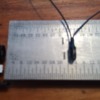Having an issue withe little switch track lanterns you get from Ross. I'm powering them with a Z1000 through the variable throttle, parallel wiring, run of thirty feet, 18gauge. the lights closest to the power burn brighter than the ones at the end of run. What can I do to make them all the same brightness. This power supply just does lights, plenty of power for the job. I don't want a separate power supply for each different type of light bulb.
Thank you
clem






